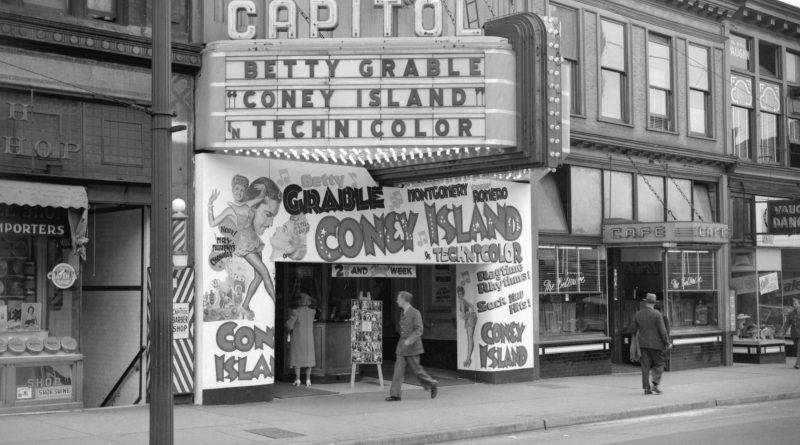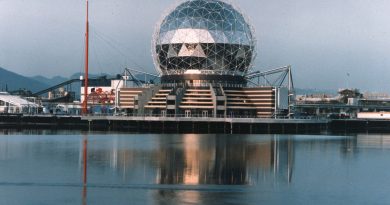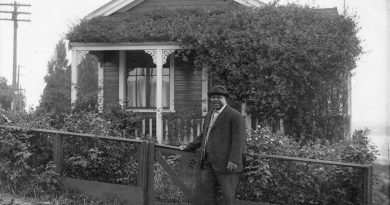1921
Above: Capitol theatre box office and marqee circa 1943
[Image: City of Vancouver Archives CVA 1184-706]
*****************************************
You’ll note that these years include events listed under “Also in . . .” These are events for which we don’t have a specific date. If YOU know the specific date of an event shown there, please notify us . . . and cite the source! Many thanks!
*****************************************
March 12 The Capitol Theatre opened at 820 Granville Street. Unlike the Pantages and Orpheum theatres, which were built to house vaudeville and live theatre, the Capitol was a pure movie palace, a lush theatre that originally seated 2,500. It was equipped with a huge Wurlitzer organ to accompany the movies. Calvin Winter and his Capitolians played at the opening.
March 21 The first game of the 1921 Stanley Cup series (a best-of-five contest between the Ottawa Senators and the Vancouver Millionaires) took place at the Denman Arena. The attendance for Game 1 was 11,000 fans, setting a new world record for the largest crowd to see a hockey game. The Senators won three games to two. The remaining dates and scores are below.
| Game-by-Game | Winning Team | Score | Losing Team | Location |
|---|---|---|---|---|
| 1 – March 21 | Vancouver Millionaires | 2-1 | Ottawa Senators | Denman Street Arena, Vancouver |
| 2 – March 24 | Ottawa Senators | 4-3 | Vancouver Millionaires | Denman Street Arena, Vancouver |
| 3 – March 25 | Ottawa Senators | 3-2 | Vancouver Millionaires | Denman Street Arena, Vancouver |
| 4 – March 31 | Vancouver Millionaires | 3-2 | Ottawa Senators | Denman Street Arena, Vancouver |
| 5 – April 4 | Ottawa Senators | 2-1 | Vancouver Millionaires | Denman Street Arena, Vancouver |
3 games to 2
March 28 Alvin Balkind, art curator, was born in Baltimore, Maryland. He came to Vancouver and became an influential member of the city’s art world.
April 15 The Canadian Bar Association, a professional, voluntary organization formed in 1896, was incorporated by a Special Act of Parliament.
April 18 Fitzgerald McCleery, farmer, died at age 82 in Vancouver. With his brother Samuel, he built the trail from New Westminster to Point Grey for a salary of $30 a month. In September 1862, the brothers were the first to farm the Fraser delta lands. Their first 15 head of cattle were shipped from Oregon. Dairy products were canoed to New Westminster and carried by steamer to Fraser logging camps. The McCleery farm in later years became a golf course. He kept a diary of his life in B.C., kept now at the Vancouver City Archives.
April 29 Famed contralto and mezzo-soprano Ernestine Schumann-Heink left Vancouver today for a tour of the Far East. It was not the first time she had been in Vancouver, and it would not be the last. We haven’t discovered yet whether this 1921 visit was just in transit, or whether she sang here.
May 4 The Vancouver Daily World had a news story on the new theatre organ at the Kitsilano Theatre. Click here to read article.
Spring Henry Green, who had convinced social leader Mary Isabella Rogers to help underwrite his subscription orchestra (the genesis of the Vancouver Symphony Orchestra) skipped town, with the orchestra’s money, never to be heard from again.
June 10 Prince Philip was born on the island of Corfu, a Greek island in the Mediterranean.
June 14 Our files read: “Jenny Dill and her husband Frank arrived in Vancouver, having walked across Canada. They left Halifax February 1.” There was a lot more to the story. It turns out there was a race across the country, and the Dills weren’t the first to arrive. There were three teams battling to win the race, and they faced terrible storms, wolves, wildcats, defective footwear . . . it was a real adventure and the whole country was following their every step! Read the details here.
June 15 A brief and ineffective period of prohibition that had started in BC in 1917 came to an end, but from this date on there would be provincial government control of the sale of spirituous and malt liquors.
June Work resumed on the Peace Arch. It had been stopped in November 1920 to allow time for the concrete to set.
July 700 tourists camped in Central Park in Burnaby. These “autoists,” as the newspapers called them, came from as far away as Eastern Canada and the U.S., and the municipality considered putting in shower baths and laundry “wash houses.” The camp closed about 1927.
August 29 The CPR’s Princess Louise, the largest passenger ship ever built in B.C., was launched at Wallace Shipyards. She was built for the CPR’s northern service, the only “Princess” to be designed and built in Vancouver. The Louise was on the run for 40 years without an incident, a record, before being sold in 1955 to become a restaurant in Long Beach, California, where she sank in 1990. There is a book about her: The Princess Story, by W. Kaye Lamb and Norman Hacking.
September 6 The Peace Arch was dedicated before a vast crowd at the Douglas Crossing on the B.C.-Washington border. BC’s Premier Oliver attended, coming from Victoria in a boat that anchored at Blaine with nearly 400 other people. In a pleasant hands-across-the-border gesture of friendship, Victoria’s 72nd Seaforth Highlanders band played the US national anthem and the Bellingham Elks band played God Save the King. Click here for more details.
October 28 A sudden flood wave at Britannia Beach crashed down on the village and swept away 50 of its 100 houses, killing 35 people. “It was at 9:30 o’clock on Friday night that the disaster happened,” the Province reported. “The creek had been growing more turbulent and, with the melting of the snow in the higher levels, the waters became uncontrollable. A dam was washed out and then a railroad fill went, and the debris carried away houses . . . Shrieks of the victims were heard above the roar of the flood.”
Also October 28 Port Coquitlam was going through rough times. A fire in 1920 had razed half the town’s commercial buildings along Dewdney Trunk Road. Today more buildings and a bridge were lost when the Coquitlam River flooded. Several businesses and St. Catherine’s Church were swept downstream. The church and the barber shop came to rest on a sandbar. By the end of the year PoCo was virtually bankrupt and council had to sell the city’s fire engine. A bad move, because a year later fire would wipe out another section of downtown.
November 17 Warren Tallman, teacher and literary critic, was born in Seattle. He will arrive in Vancouver in 1956.
November 21 The Vancouver Electrical Show opened at the Drill Hall.
December 6 The first federal election was held in which women had the vote. This is the election that first brought Mackenzie King in as prime minister. (He defeated Arthur Meighen’s Conservatives.) It was also the first minority government in Canadian history. King’s Liberals had 116 seats, the opposition’s seats totalled 119.
Also in 1921
UBC appointed its first Dean of Women, Mary Louise Bollert. She was not paid anywhere near what the male deans made. Ms. Bollert was one of the founders of the B.C. Teachers Federation—inspired, in part, by the desire to push for pay equity for women teachers. UBC has honored her in Mary Bollert Hall, now used by the university’s Development Office. She retired in 1941, and ran provincially (unsuccessfully) for the Liberals that year in Vancouver-Point Grey. Born in Guelph, Ontario in 1884, she died August 1, 1945 in Vancouver.
The town of Ioco was completed by Imperial Oil. The name comes from the company’s initials.
The Norsal was launched at Menchion’s Shipyards in Vancouver. She was built for the Powell River Co., a major forest products firm. A contemporary story reported that the boat is “the largest power yacht of its type built on this coast, being 132 feet over all . . . with a draft of about eight-and-a-half feet . . . The boat is twin-screw with two 200-h.p. Fairbanks-Morse engines of the semi-diesel type, which are expected to give her a speed of 15 miles an hour . . .” The boat was named for Norman and Sally Lang, the children of Norman Lang of the Powell River Co. (Sally would eventually become the mother of Senator John Nichol.) The Norsal will make her maiden voyage May 29, 1922.
A fellow named John Putnam visited Vancouver, saying he was going to put Vancouver on the movie-making map. He somehow got hold of a stack of city stationery and sent invitations to kings and prime ministers all over the world, telling them to come here (at the city’s expense) for a vast celebration to begin the project. A few people replied with thanks, before a couple of white-coated gentlemen showed up to escort Mr. Putnam back to the Seattle hospital from which he had escaped.
The Western Canada Hockey League began. Its name was changed to the Western Hockey League in 1926, then later that same year to the Prairie Hockey League. It folded in 1928. The Vancouver Maroons were in the league from 1924-25.
The bronze memorial Winged Victory (this may not be the correct title) was erected outside the CPR station on Cordova Street in Vancouver. The work commemorated Canadian Pacific Railway employees who had lost their lives in the First World War. There were, astonishingly, 1,100 of them. Copies of the memorial went up in Winnipeg in 1922 and at Montréal’s Windsor Station in 1923. After the Second World War, a plaque was added to the statues as a tribute to soldiers in that war. The sculptor, commissioned by the railway after a nation-wide search, was the grandly named Coeur de Lion MacCarthy. He was the son of a British-born artist with an equally splendid name, Hamilton Plantagenet MacCarthy. MacCarthy’s war memorial is a big piece of work. Exclusive of the base it stands seven feet high and weighs 3,000 pounds. That splendid photograph is the work of Jim McGraw.
Scotland-born Lily Laverock began her work as an impresario in Vancouver. Over the next couple of decades this former newspaper writer (the first woman reporter in the city) brought to the city, through her International Celebrity Concerts, such figures as Geraldine Farrar, Jascha Heifetz, Fritz Kreisler, Nellie Melba, John McCormack, Maurice Ravel, and Sergei Rachmaninoff, and such ensembles as the Don Cossack Singers and the Ballet Russe de Monte Carlo, an effort that made a profound contribution to the musical life of Vancouver. She suspended her concert sponsorship at the beginning of World War II and retired in the early 1950s.
The Sannie Transportation Company began a ferry service between Horseshoe Bay and Snug Cove on Bowen Island. It started with three round trips a day, more on weekends. The fare will remain at 25 cents for 30 years!
Richmond won top prizes for its agricultural produce at the Vancouver and Victoria Exhibition. Both the quality and the diversity of produce—grain, forage crops, vegetables, berries, tree fruits and dairying—was evident. Richmond becomes the cranberry capital of North America.
A library opened in West Vancouver, but later closed during the Great Depression. Not until the 1950s would a library open here again.
The Province had this Daily Chuckle: Jenkins was sitting down to breakfast one morning when he was astounded to see in the paper an announcement of his own death. He rang up friend Smith at once. “Halloa, Smith!” he said. “Have you seen the announcement of my death in the paper?”
“Yes,” replied Smith. “Where are you speaking from?”
Construction began on Ballantyne Pier. It would be finished in 1923. Although only a cargo-storage and loading facility for Vancouver’s busy port, the original pier was designed more as a triumphal gateway to the city than a warehouse.
The east half of False Creek was filled for yards of the Great Northern (now Burlington Northern) and the Canadian Northern Pacific (now part of Canadian National Railways). An 1876 bridge that crossed the creek was removed.
Smith Bros. & Wilson, founded in Grand Forks in 1897, moved its headquarters to Vancouver. The firm built such landmarks as the Seaforth Armouries, the main post office and the Board of Trade Tower.
The Fire Wardens Branch, responsible for inspections, enforcing fire by-laws and investigation of fire scenes, was formed in Vancouver. It replaced a police sergeant who had enforced the fire by-law part-time for many years.
The postwar census, just two years after World War One ended, showed a decline in B.C. of nearly 40 per cent of people declaring their German origin. In public people of German ancestry now spoke English only. Beginning in 1922 all Germans entering Canada had to register as enemy aliens. That was a short-lived regulation.
The Schara Tzedeck (Gates of Righteousness) synagogue was opened.
In 1921 Vancouver’s first synagogue, the B’Nai Yehudah (Sons of Israel), built in 1911-12 on the southeast corner of Heatley Avenue and East Pender, was stuccoed over to match the new Schara Tzedeck. Today, researcher Dave Berner says, that site is irreverently known on the street as Beth Condo, since the old building became, as a part of the gentrification of Strathcona neighborhood, a compact of privately-owned apartments.
The Vancouver School Board named a school after David Lloyd George, the former Prime Minister of Britain.
Julian Hedworth George, Viscount Byng of Vimy, became Governor General of Canada. He would serve to 1926. Lord Byng School is named for him.
The staff at St. Paul’s Hospital devised a machine that controlled ether administration in the operating room.
A ward for children opened at Mount St. Joseph Hospital.
The Vancouver Central Lions Club was founded. It is the oldest Lions Club in British Columbia and the second oldest in Canada. (Today, there are 26 Lions Clubs in Vancouver, 55 in the lower mainland. As well, there are about 25 Lions Ladies Clubs, the first of which was established in 1937.)
The Women’s Auxiliary to the Rotary Clinic for Chest Diseases was formerly established. For two years prior it had been an informal association of wives of Vancouver Rotary Club Members who met weekly at the newly opened Rotary Clinic to make hospital garments and clothing for patients.
The Vancouver Little Theatre Association, possibly Canada*s oldest continuously operating community theatre company, was formed. Their first play, Lonesome Luke (directed by Frederic Wood), was presented in a 200-seat auditorium at Templeton Hall at Pender and Templeton.
The Association of Professional Engineers of British Columbia was formed through the Engineers Act to establish the qualifications necessary to practice.
Henry John Cambie, railway engineer, retired. (Not a locomotive engineer, but a man who worked out the railway’s routes.) Cambie Street is named for him.
C.H. Cates Towing became Charles H. Cates & Son. Charles’ son and partner was John Henry Cates.
Laura Emma Jamieson organized a branch of the Women’s International League for Peace and Freedom.
Leon Johnson Ladner, lawyer, a founder of UBC convocation and of Ladner, Downs, one of Vancouver’s largest law firms, became the Liberal Conservative MP (yes, you read that right) for Vancouver South. He will serve to 1930.
Ronald Bick Lee, businessman and community leader, founded Foo Hung Co., a leading importer of Asian goods.
Angus MacInnis, politician, began his long public service with election to the Vancouver School Board. He will go on to become an MP for Vancouver East. (MacInnis Park in East Vancouver was named for Angus and his wife Grace.
William Ferriman Salsbury, railway executive, stepped down as the CPR Pacific Division’s treasurer after 35 years. An east end street is named for him.
Perth, Australia-born Dorothy Somerset, theatre director, moved to Vancouver. She will become a major force in the city’s theatre world.
William Lamont Tait, lumberman, died. He had arrived in Vancouver February 13, 1891, later opened Rat Portage Lumber, a shingle and sawmill on False Creek (1902-1910). His Shaughnessy mansion, Glen Brae, built in 1910, had one of the city’s first elevators. “He spared neither expense nor effort to make his home the latest in living luxury.” He was one of the first to hire workers from the False Creek Indian Reserve and East Indians. Today, Glen Brae is Canuck Place, a children’s hospice.
Fritz Ziegler established Ziegler Chocolate Shops.
The 1921 census showed these population figures:
| Burnaby | 12,873 |
| Coquitlam | 2,374 |
| Delta | 2,839 |
| Fraser Mills | 600 |
| Langley | 4,881 |
| Maple Ridge | 3,772 |
| New Westminster | 14,495 |
| North Vancouver City | 7,652 |
| North Vancouver District | 3,800 |
| Pitt Meadows | 595 |
| Point Grey | 13,736 |
| Port Coquitlam | 1,178 |
| Port Moody | 1,030 |
| Richmond | 4,825 |
| South Vancouver | 32,482 |
| Vancouver | 117,217 |
| West Vancouver | 2,434 |


![Women's Ambulance Corps [Vancouver Unit]](https://vancouverhistory.ca/wp-content/uploads/2020/11/b2c3395a-3c9d-4179-a85a-6aed250e77bf-A14388-390x205.jpg)

